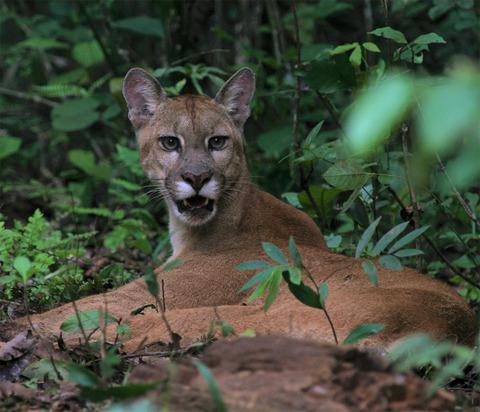当前位置:
X-MOL 学术
›
Anim. Conserv.
›
论文详情
Our official English website, www.x-mol.net, welcomes your feedback! (Note: you will need to create a separate account there.)
The importance of forests for an apex predator: spatial ecology and habitat selection by pumas in an agroecosystem
Animal Conservation ( IF 3.4 ) Pub Date : 2020-11-25 , DOI: 10.1111/acv.12659 F. C. Azevedo 1, 2, 3 , F. G. Lemos 1, 3 , M. C. Freitas‐Junior 1, 3 , R. C. Arrais 1, 4 , R. G. Morato 5 , F. C. C. Azevedo 6, 7
Animal Conservation ( IF 3.4 ) Pub Date : 2020-11-25 , DOI: 10.1111/acv.12659 F. C. Azevedo 1, 2, 3 , F. G. Lemos 1, 3 , M. C. Freitas‐Junior 1, 3 , R. C. Arrais 1, 4 , R. G. Morato 5 , F. C. C. Azevedo 6, 7
Affiliation

|
The maintenance of viable carnivore populations along human-dominated landscapes depends on the understanding of the species requirements that are critical to the design of global actions focused on their conservation. Using resource selection function and a spatial analysis approach, we evaluated large carnivore habitat use in a disturbed landscape by studying pumas in a rapidly developing region in Southeast Brazil. Pumas had a mean home-range size of 203.7 ± 39.8 km2 and showed pronounced territorial behavior through intrasexual overlap (males 22% and females 60%). Our results also revealed a strong habitat association with forest vegetation both at population and individual levels, followed by pasture with shrubs, a type of anthropized habitat that offers cover and prey; the use of this type of landcover was more frequent during night hours. Our study is the first robust home-range estimation of pumas in Brazil and fills a gap in puma's ecology knowledge in anthropized tropical environments, highlighting the importance of natural habitat patches to this predator along human-modified areas and reinforcing the species demand for vast and forested areas to thrive. In areas where conservation goals include the maintenance or increase in large predator populations, identifying the limits imposed by anthropogenic landscape changes, and ensuring that these are not exceeded, is paramount for conservation initiatives.
中文翻译:

森林对顶级捕食者的重要性:美洲狮在农业生态系统中的空间生态和栖息地选择
在人类主导的景观中维持可行的食肉动物种群取决于对物种需求的理解,这些需求对于设计专注于其保护的全球行动至关重要。使用资源选择功能和空间分析方法,我们通过研究巴西东南部快速发展地区的美洲狮,评估了受干扰景观中大型食肉动物栖息地的使用情况。美洲狮的平均家庭范围为 203.7 ± 39.8 km 2并通过性交重叠表现出明显的领土行为(男性 22% 和女性 60%)。我们的研究结果还揭示了在种群和个体层面与森林植被的强烈栖息地关联,其次是带有灌木的牧场,这是一种提供覆盖和猎物的人类化栖息地;在夜间更频繁地使用这种类型的土地覆盖物。我们的研究是巴西首次对美洲狮进行可靠的家庭活动范围估计,填补了美洲狮在人类化热带环境中生态学知识的空白,突出了自然栖息地斑块对人类改造地区的这种捕食者的重要性,并加强了对广阔和森林地区蓬勃发展。在保护目标包括维持或增加大型捕食者种群的地区,
更新日期:2020-11-25
中文翻译:

森林对顶级捕食者的重要性:美洲狮在农业生态系统中的空间生态和栖息地选择
在人类主导的景观中维持可行的食肉动物种群取决于对物种需求的理解,这些需求对于设计专注于其保护的全球行动至关重要。使用资源选择功能和空间分析方法,我们通过研究巴西东南部快速发展地区的美洲狮,评估了受干扰景观中大型食肉动物栖息地的使用情况。美洲狮的平均家庭范围为 203.7 ± 39.8 km 2并通过性交重叠表现出明显的领土行为(男性 22% 和女性 60%)。我们的研究结果还揭示了在种群和个体层面与森林植被的强烈栖息地关联,其次是带有灌木的牧场,这是一种提供覆盖和猎物的人类化栖息地;在夜间更频繁地使用这种类型的土地覆盖物。我们的研究是巴西首次对美洲狮进行可靠的家庭活动范围估计,填补了美洲狮在人类化热带环境中生态学知识的空白,突出了自然栖息地斑块对人类改造地区的这种捕食者的重要性,并加强了对广阔和森林地区蓬勃发展。在保护目标包括维持或增加大型捕食者种群的地区,


























 京公网安备 11010802027423号
京公网安备 11010802027423号